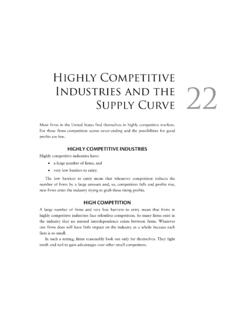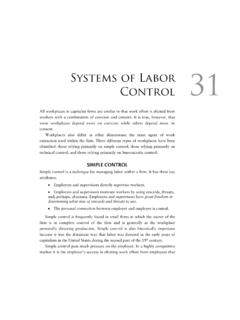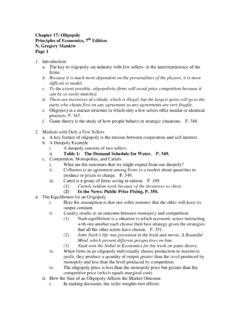Transcription of 1Ol - CSUSB Department of Economics
1 oligopoly 1. 19. As you move your cart down the grocery isle, stop in front of the canned soups. You see before maybe four or five different brands of soup. If you stop in front of the frozen pizzas you might find that 8 different pizza brands are for sale. But take a close look at some of the boxes: you will find that behind these different brands are perhaps only three different firms that operated under a couple of different names. As you move through the grocery store you will find you have a choice between only a relatively few producers for most types of products. Indeed, if you visit a grocery store in a different part of the United States you will find that the exact same companies that provide the products in your local grocery store produce most of the products available in this other store too.
2 For the most part, you only encounter products produced under competitive conditions many firms selling in the market only when you move to the produce section of the store: apples, broccoli, and potatoes are generally produced by firms in competitive markets. When you go to buy a car, you find that almost all of the cars available are produced by a relatively small number of firms: Ford, GM, Honda, Toyota, and a few other firms produce a vast majority of cars sold in the United States. If you go to rent a video a good chance exists that you rent from either Hollywood Video or Blockbuster. If you decide to buy a ping-pong table you do find many different brand names labeling ping-pong tables. However, behind the many brand names in the are really two different ping-pong producers that sell their products under many different names.
3 The examples could go on and on: most products you buy on a yearly basis are produced within industries in which a relatively few firms dominate. Industries in which a few firms dominate are called oligopolies. 188 oligopoly oligopoly DEFINED. The key characteristic of an oligopoly market is that a few sellers dominate the market. An oligopoly market might have dozens or even hundreds of individual firms but most of them are unimportant in the industry; a small number of them perhaps only 2 to 20 firms dominate the industry. In what way might these firms dominate the industry? These firms are much larger than the other firms in the industry and they have a dominant role in determining the prices in the industry.
4 The other, smaller firms in the industry are often minor niche marketers who only survive in the same industry with the giant firms because these smaller firms sell a line of goods that oligopoly firms are not interested in selling. Perhaps the markets for these particular lines are too small and too unprofitable to make with worth the while of the oligopoly firms. For instance, dozens of firms sell dry breakfast cereal in the United States. But, the dry breakfast cereal industry is considered to be an oligopoly because a few firms dominate industry sales. For instance, the largest four firms in this industry account for 80-90% of all cereal sales in the United States. The other, smaller, firms in the industry sell cereals that only a relatively few people buy.
5 TWO UNIQUE ASPECTS OF oligopoly COMPETITION. In oligopoly industries, competition occurs in ways that are unique to these industries. Two unique aspects of oligopoly competition are mutual interdependence and repeated interaction. MUTUAL INTERDEPENDENCE. Mutual interdependence exists when the actions of one firm has a major impact on the other firms in the industry. For instance, if Coke decides to sell more of its product (and to do so they reduce their prices), Pepsi will certainly notice that its sales fall. Coke's behavior affects Pepsi: mutual interdependence exists with in the US soft drink market. But, if a corn farmer in Kansas decides to plant another few more of corn, the sales of other corn farmers in the US will not be affected.
6 An individual corn farmers' output is a very small part of US corn output; changes in output by one farmer will have no impact on the corn market. Mutual interdependence does not exist in the corn market. Mutual interdependence exists within an oligopoly industry because each of the oligopolists has a sizable part of the market. As a consequence, when it oligopoly 189. changes its sales, its prices, or its marketing strategies, this oligopoly firm will likely affect the sales of other firms within the industry. An analogy is the following. If you are on a ocean liner that holds 1,000. people you can stand up and jump up and down and have no effect on the other passengers. This is because you are very, very small compared to the boat and to the number of other passengers on the boat.
7 But, if you are in a small rowboat with 2 other people and you stand up the other 2 people will instantly notice that the boat is more unstable and, perhaps, threatens to capsize. They must actively shift their weight to keep the small boat from tipping over. The 3 people in the small row boat are mutually interdependent: what one person does can directly affect what happens to the other people on the boat. REPEATED INTERACTION. Often the oligopolists within an industry have been competing with one another for a long time. For instance, Pepsi and Coke have competed within the same market for decades. Ford, GM, and Chrysler have faced one another in the US auto market for a very long time. Oligopolists in other markets might have competed with one another for a much shorter period of time, perhaps only a few years.
8 But, in each of these cases, the oligopolists within these industries have experience with the others within the industry. For instance, whenever Pepsi decides to lower the price of its products it knows how Coke responded in the past to previous reductions in price by Pepsi. Perhaps Coke matches a Pepsi price reduction 10 out of the past 12 times Pepsi reduced its prices. In this case, Pepsi likely anticipates that when it lowers its prices this time, the odds are that Coke will respond in kind. Coke, on its part, also remembers what happened in its past competitive interactions with Pepsi. Coke and Pepsi remember, and take into account, what happened in the past when they design their current competitive strategies.
9 The situation is characterizes as repeated interaction. The existence of repeated interaction does not imply, however, that Pepsi or Coke know with perfect certainty how their rival will react to the current strategy. They do have, however, some general sense of what is most likely to occur and they take into account this anticipated response when they design their current competitive strategy. I return to the rowboat analogy. When you stand up the first time in the small rowboat perhaps the two other passengers yelled at you with scowls on 190 oligopoly their faces. As a consequence you sit down not wanting to incur the wrath of your fellow passengers. Ten minutes later you stand up a second time. Again, your fellow passengers make clear their displeasure with your behavior.
10 Perhaps one of the passengers picks up an oar and raises it menacingly. You sit down again. After another 15 minutes you think about standing up again, but remembering what happened in the past, you decide not to do so. So, you stay put. Because of the repeated interaction and your remembering of what happened in the past, you are able to take into account these past interactions as you decide what to do or not do in the current moment. REPRESENTATION OF COMPETITION BETWEEN. OLIGOPOLIES. A simple diagram can illustrate the nature of competition within an oligopoly industry. Recall that in a monopoly industry, the single seller faces the market demand curve. This demand curve represents the collective behavior of all of the consumers in the market.











